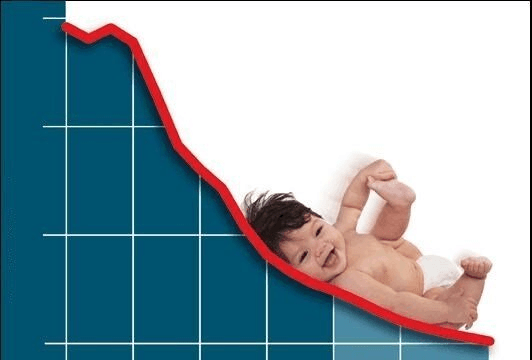
Fertility rates around the world have been falling for decades. The U.S. and many other developed countries are now below replacement level, meaning not enough children are being born to replace the number of people dying. Many of us consider this to be good news—our population is naturally on the path to a more sustainable level. But some people say the lack of births predicts the beginning of human extinction. Is that realistic?
In short, if we do not have enough babies to replace ourselves, then someday the last human will walk the Earth. That is a mathematical fact. But just how soon is someday? The answer is a very very long time.
To see why, follow a simple example. Suppose you have a population of 1,000 and that each couple has one child only. It is easy to understand that the next generation will have 500 people. The next will have 250, and so on. It takes approximately eleven generations to actually go extinct*:
First generation | 1,000 |
Second generation | 500 |
Third generation | 250 |
Fourth generation | 125 |
Fifth generation | 63 |
Sixth generation | 31 |
Seventh generation | 16 |
Eighth generation | 8 |
Ninth generation | 4 |
Tenth generation | 2 |
Eleventh generation | 1 |
* This simple example assumes all babies survive to reproduce, all members are fertile, and an odd number of the population accommodates the one unmatched male or female. It also allows for less than a whole person (whole number).
The current population of the United States is 331.9 million and the Total Fertility Rate (TFR) is 1.78 (there are 1.78 births per woman), which is far above our hypothetical example. At those numbers, it would take more than 50 generations for the U.S. to empty out—over 1,000 years. This calculation does not consider immigration or any future changes to trends.
Globally, the Total Fertility Rate is 2.4 children per mother, well above the replacement rate. Humans are still increasing in number—there is currently no basis to the belief that our species is on the path to extinction due to low birth rates. However, human extinction from a catastrophic man-made or natural disaster could happen very quickly. Think nuclear war or environmental collapse (extinction of pollinators, toxic accidents, global warming past a tipping point), each one being a symptom of overshoot and each caused by too many people demanding too many resources and generating too much waste. Fearing low birth rates is like obsessing about cancer while playing blindfolded in traffic.
Here at Earth Overshoot, we are doing what we can for the survival of the species, targeting the most likely cause of our extinction that we can control - exhausting or polluting our environment past the point of human survivability. One day, we will need to recover fertility rates to about 2.1 children per woman to achieve a stable and sustainable population, but that is a far distant worry.*
*The discussion here is simply about the mathematical reality of how long it takes for low birth rates to actually lead to extinction. A complete discussion of declining population numbers would consider the effects of migration, human health, fertility trends, and the changing educational quality and economic productivity of a population. India and China are providing a real life case study of the importance not just of the number of its citizens but also its characteristics.

